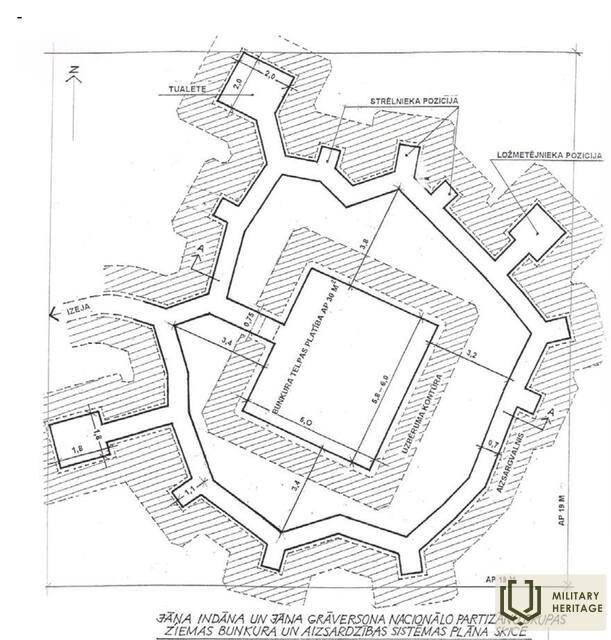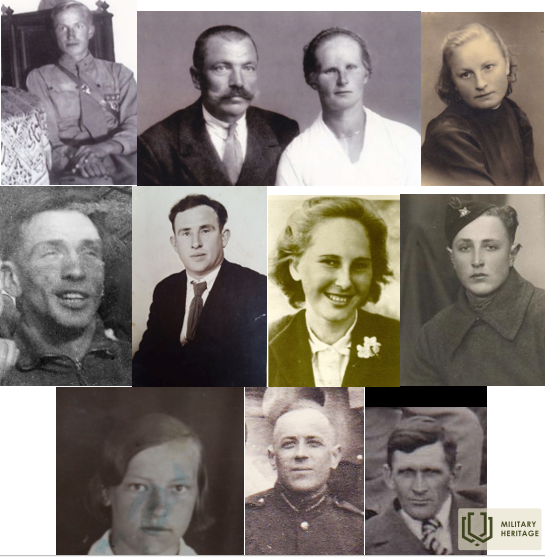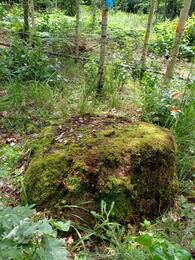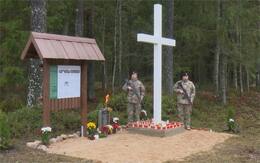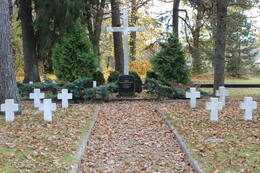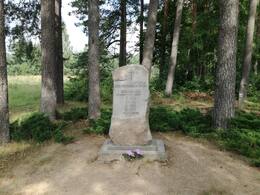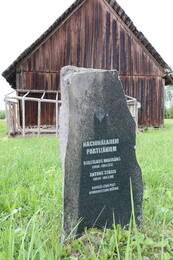Settlement of Sēlija forest brothers in Sūpe bog
Sūpe swamp is connected with the places of guerrilla settlements and fighting, which have developed in the interaction of people and places. This is described in the ballad of the Latvian exile Albert Eglītis about the events in his homeland in Sūpe mire "Moss and mud" - a tribute to the partisans of Sūpe mire:
„“ In 1945, glowing in the swamp
On Pokļevinska's birthday, Lieljānis shares dinner:
Willow fermented beer,
Romulan cult butter,
Dry mother's cumin bread
Dried ham,
And Stucka onions,
Long cheese.
Rooms in resinous walls
Dun lightning struck hearts,
And eleven souls
Ground roots… .. ”
This interpretation of the past with the post-World War II events included human testimony, the expression of the spirit, and a system of values. It is a reminder of the popular support given to the national partisans, who could not be so easily defeated by the occupying power. After the deportations of the population on March 25, 1949, the supply system of the national partisans was destroyed. From the summer of 1949 to the middle of 1952, the Sēlija national partisan resistance movement was in decline around Aknīste, Biržai, Elkšņu Gārsene, Sauka, Susēja and Viesīte. The defeat came from ethnic cleansing and from regular army and security service activities.
The Indan-Gravelson settlement, with such a serious system of protection, no longer existed anywhere else in Latvia in the 1950s, including Lithuania, the southern neighbor of Selia. The Indan-Gravelson group bunker in the Elkšņi forest in the winter period of 1949-1950 is characterized by a unique fortress at that time. With specially designed circle protection grooves and weapon sockets. Family members could not be separated, and the responsibility for their safety was taken primarily by men who had gained military experience, as well as by the women themselves, who were not afraid to take up arms. Their purpose in the event of danger was to repel the attacker. This special identity, which manifested itself in the final stages of the war, is characterized by the involvement of family members, who escaped repression. It was also manifested in psychological preparation, and the fateful outcome was no longer a surprise. The Indan-Gravelson group was well aware of its hopeless situation and was ready to fight to the death.
Indan-Gravelson Joint National Partisan Group:
Group leader Jānis Indāns, Pēteris Indāns, Kristīne Indāne, Milda Ārija Indāne, Vasilijs Sokolovs, Jānis Ķepiņš, Hilda Deputy, Artūrs Snikus, Alma Grāvelsone, Second group leader Jānis Edvards Grāvelsons, Jonas Žukauskas.
Oral testimony
Partisan liaison Jānis Snikus: “Mārtiņš Pokļevinskis showed the common partisan grave and said that he had pulled my brother Artūrs Snikas to the top of the grave, placing his head towards the north. Mārtiņš Pokļevinskis claimed that the partisans had given their heads too cheaply, because they had to leave the bunker only when it got dark, then break through. A wreath was placed on the partisan common grave. Together with Mārtiņš Pokļevinskis, we hurriedly buried the partisan Voldemārs Sātnieks, who had been left as buried in the forest as possible. ”
Vilma Birša (Saulīte): “1950. In the spring of 2006, before capturing, Mārtiņš Pokļevinski and I were watching the Indan-Gravelson bunker, and we found a partisan burial ground not far from the bunker. Pokļevinskis tried to turn the fallen to see with a long card, I could clearly see the Indans, Snikus Artūrs and Mildiņš. I couldn't watch any more because it was all unbearably heavy. Soldiers' hats were thrown at the scene of the battle. You could see the places where the troops were disguised as spruce branches and waiting for the partisans to leave the bunker. ”
Jānis Plāns: “I was working at the Viesīte railway station on a train and on that date I had to drive to load timber at the 22nd kilometer of the Elkšņi branch. As we approached the 14th kilometer, we were stopped by an army order because the shooting had started. ” After the shooting, Jānis Plānis was ordered: “ложись” - to lie down. Jānis Plānis executes the order and lies on the train platform. As the train passed the firing range, he could see soldiers in white camouflage clothes behind each tree. When approaching 22 kilometers, even more intense firing resumed. "When we put the timber back on the train, the shooting was over, but the whole forest was still surrounded." After these events in the summer month at the 14th kilometer, when they loaded timber together with the driver, Jānis Plāns went to see the scene. Arriving at the bunker, you could see such a small hill, small Christmas trees growing around it. The bunker had remained intact with all the trenches, entering the bunker it was empty, the ceiling was not high, but the body could be straightened. Inside the bunker, Jānis Plāns remembers that there was a table and in front of the entrance you could see the benches on two floors. There is a sauna with a stone hearth 10 meters from the bunker.
Hilda Miezīte (Deputy): “The attack took place in the morning, there was still a little snow. It was a betrayal and it was a ranger. ” Hilda Miezīte remembered that she could hear the roar of cars all around, and additional forces had come. Hilda doesn't understand how she survived because the bullets went from all sides. She thought they left the bunker because they would not be able to hold on, grenades were thrown and loudspeakers were heard. The settlement would be destroyed one way or another. While living in the forest, no one was allowed to leave the settlement, strict discipline prevailed, and nicknames existed in order not to reveal their identity. The men have changed regularly in the guard post. The roof of the bunker was built of round logs, it was low with a small elevation, covered with earth, sod and moss. On the entrance side, a small elevation with a slight slope to the opposite side. To the right of the entrance door was a small window. There were benches in the bunker and the stove was in the middle. There were not many things, household items - clothes for some as much as on the back. A phonograph with vinyl records was played in the premises of the settlement, which was sometimes listened to quietly.






Christmas tree. Songs of the Sunless Time: Lyrical Notes of a Journalist. [Minneapolis]: Selzemnieks, 1983, p. 28.]
Related timeline
Related objects
Memorial stone to the Rihards Pārups group of national partisans
It is located on Rīgas Street near the Krustpils Lutheran Church.
On September 22, 1996, a memorial stone to Rihards Pārups and the group of national partisans led by him was unveiled in Krustpilis. The memorial stone was created by the sculptor Ilgvars Mozulāns, but its creation was financially supported by the speaker of the Saeima, Ilga Kreituse. This event was organized by the board of the National Partisan Association of Latvia...
Memorial place for the members of P. Prauliņas national partisan group in Vidsala
The group of national partisans of Pētera Prauliņa (1911-1949) of Biržu parish was part of the group led by Mārtiņas Pokļevińskas (1902-1951). The group carried out several partisan actions in which they punished Soviet collaborators and requisitioned food and property of the economic institutions of the occupying power. The partisans of P. Prauliņa's group did not observe sufficient conspiracy, many persons visited their settlement, which created an opportunity for betrayal. Lack of military experience was one of the weaknesses of the guerrilla armed movement.
...Bunker site of P. Prauliņa's national partisan group
The place of P. Prauliņa's bunker is located in the 4th district of the 99th block of Vidsalas, Kalna parish. The stone on which P. Prauliņš sat has been preserved.
The partisan group of P. Prauliņa (1911-1949) was destroyed on May 16, 1949, during the operation of the Ministry of State Security of the LPSR in the Kalna forest of Biržu parish, in which military units also participated. The Forest Brothers had created a bunker with circle defenses, well camouflaged and located at an indeterminate height in a swampy area. The partisans...
Memorial place for members of J. Indan - J. Gravelson and M. Poklevinska national partisan groups
Informative stand and memorial place for Indān - Gravelson's national partisan group in Kalna parish of Jēkabpils county, in the vicinity of Sūpes purva, opened on Lāčpleš day - November 11, 2019. Its opening was attended by representatives of Jēkabpils and Viesītes counties, former national partisan H. Miezīte, historian H. Bruņinieks, as well as guests from Lithuania and other interested parties. The memorial site and the stand are located by the Sūpe swamp, which is connected to the places of settlements and battles of the national partisans. Deeper in the forest was also the bunker of the Indan-Gravelson group.
...Memorial site at the site of the battle of the national partisans on February 13, 1945 in Dimantu Meze, Kalna Parish
The memorial site has been created by the regional highway P74 Siliņi - Aknīste, 12 kilometers from Aknīste turning to the Latvian national forest "Žagaru road".
At the end of the summer of 1944, the vast forest massif of the northern part of Elkšť parish became a gathering place for people who were preparing for an armed struggle against the Soviet occupation. At the end of 1944, groups of national partisans began to form around Aknīste. A suitable place for the establishment of a partisan camp was the Dimantu mež , which was located...
Cemetery of the Brothers of the National Partisans of Selia
The graves of the brothers of the national partisans of Selia were opened on October 30, 2004 with the support of the Ministry of Defense of Latvia and Aknīste municipality. Partisans Alberts Karankevičs (1914-1949), Vilis Tunķels (1911-1949), Arnolds Tunķels (1926-1949), Osvalds Tunķels (1929-1949), Ēvalds Kundzāns ( 1927-1949).
partisans Juris Alfreds Voldemārs Lācis (1908-1945), Eduards Kaminskis (1910-1945), Osvalds Mežaraups (1911-1945), Alberts Mežaraups (1915-1945), Antons Bružiks (1911-1945), Jānis...
The former Susėja Parish Hall, the site of an attack by national partisans on July 7, 1945
Today, the building of the former Susėja Parish Hall houses the Sansusī Residence Center and the guest house "Susēja". On the facade of the building you can still see the traces of the attack, left by the bullets fired during the attack of the national partisans on July 7, 1945.
The former Susėja Parish Hall, which at that time functioned as the local executive committee of the Soviet occupation power, suffered an attack by the Selia national partisans on July 7, 1945...
Monument to the national partisans of Susea
The unit of national partisans of Susea was formed from smaller, fragmented groups of forest brothers, because initially there was a lack of a leader who could unite them. Artūrs Grābeklis, later Markeis Gorovņov, who died in the winter of 1945, tried to coordinate the activity of Susėya partisans for a short time. The strengthening of the national partisan unit of Suseia took place after the arrival of the former legionnaire Alberts Kaminskis in Selia after the general capitulation of Germany in Kurzeme. He established stricter discipline and united smaller groups for a common struggle against the Soviet occupation. Cooperation was also formed with groups of forest brothers from nearby parishes and surroundings, especially with the Gārsene group and...
Memorial place for Latvian and Lithuanian national partisans
The white cross with a stele for the national partisans of Slate in Rubene parish was consecrated on October 25, 2002.
It was a joint group of Latvians and Lithuanians, led by Jāzeps Fričs (1920-1947). The group also included Lithuanian partisan commander Jozas Streikus (1923-1962), Jānis Ruzga (1924-1948) and other national partisans who actively resisted the Soviet occupation regime in Slate and nearby parishes.
...Memorial site at the site of the July 2, 1945 battle of the national partisans
A memorial stone to the national partisans Jānis Abaron, Vladislav Būkas, Pēteris Bernāns, Alberts Klimans, Vladislavs Dilans and Juris Timšanas who fell in the battle of Dunava on July 2, 1945 and were then burned in Rubene parish.
The Battle of Dunava broke out after two officers of the People's Commissariat of Internal Affairs of the LPSR and one militiaman fell in the clashes between forest brothers and...
Monument to national partisans B. Mikulanas and A. Staris
The monument to the national partisans of the Ilūkstes partisan regiment of the Latvian National Guards (partisans) association Boļeslav Mikulānas (1918 - 1951) and Anton Staris (1909 -1953) in the "Kuršu" homestead in Celminiekos, Dunava parish, was opened on November 1, 2003, following the initiative of Gunārs Blūzma, a researcher of the national partisans of Selia .
From August 1944, B. Mikulāns was active in various national partisan groups, including the Bebrene group and the Dignāja group in 1949. 1949/1950 B. Mikulāns together with A. Stari hid with...




